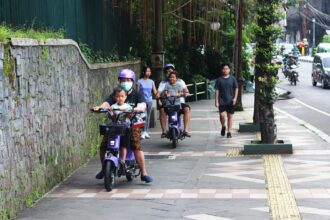The Gate of Suryakencana is not a historical structure. However, considering its function and the meaning behind the development of the gate inaugurated at the end of 2015, the gate is more than worth to be given an article.
Bogor, not long ago, has been granted a painful title by one non-governmental organization, SETARA Institute, as the most intolerant city in Indonesia. It was awarded because some of the policy issued by the Rain City governments seems to discriminate the minor ethnic and society.
The Gate of Suryakencana shows the opposite. It was set up with the mind of a minority ethnic behind, Chinese ethnic.
The architetural style used in the gate definitely adapted chinese culture. The red color, the main color in Chinese culture that represents fortune is painted. Two guardian lion statues sit near the gate pillars, one for each. Many other components shows about the influence of Chinese culture.
The gate was built in Suryakencana street that is known widely as Bogor’s Chinatown. Even though, actually people who lives inside the area is more multiethnic than just Chinese.

More than just a gate, the Gate of Suryakencan should be seen also as the representation of the acceptance of Chienese society in Bogor. Although their numbers are less than Sundanese or other Indonesian ethnics, they have been an inseparable parts of the city and society history.
Chinese people have lived side by side with other ethnics since 18th century. Peacefully. Only the policy applied on them during the New Order Regime made them like foreigners but in reality they are Bogorians more than Chinese.
They study in the same scholl. Many can speak Sundanese. Many have married with Sundanese or Javanese.
All of these things might have been overlooked by researchers from Setara Institute. The tolerance have been here since a long time ago.
That is why the Suryakencana gate can also be seen as the symbol of the acculturation and tolerance in the Rain City. That’s why it deserves to be told to outside people. There is tolerance in Bogor.


![[PHOTO] A Street Portraitist on Juanda Street Still Exist](https://lovelybogor.com/wp-content/uploads/2023/09/PHOTO-Street-Portraitist-on-Juanda-Street-Still-Survives-330x220.jpg)

![[PHOTO] How Subsidized LPG (Liquid Petroleum Gas) Distributed in Bogor?](https://lovelybogor.com/wp-content/uploads/2023/09/How-Subsidized-LPG-Distributed-in-Bogor-330x220.jpg)

![[PHOTO] No Longer Just A Town, Bogor is a Metropolis](https://lovelybogor.com/wp-content/uploads/2023/09/No-Longer-Just-Town-Bogor-is-a-Metropolis-330x220.jpg)

![[Photo] The East Side, The Old Parts of Bogor Commuter Train Station](https://lovelybogor.com/wp-content/uploads/2022/09/The-old-part-of-Bogor-Commuter-Train-StationIMG_4233-330x220.jpg)
![[Photos] Old Machine Guns From Indonesian Independence Era – Bogor Perjuangan Museum](https://lovelybogor.com/wp-content/uploads/2022/09/Old-Machine-Guns-From-Indonesian-Independence-Era-Bogor-Perjuangan-Museum-3-330x220.jpg)
![[Photos] Two Landmarks of Bogor City – Kujang Monument and The Nine Gates](https://lovelybogor.com/wp-content/uploads/2022/09/Photo-Two-Landmarks-of-Bogor-City-Kujang-Monument-The-Nine-Gates-330x220.jpg)